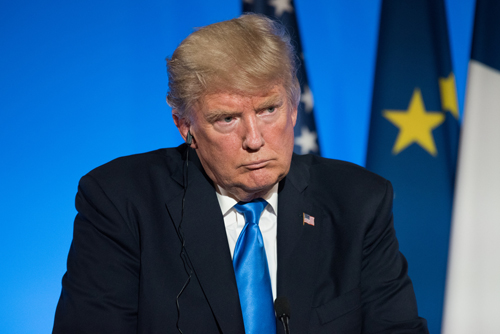Can Trump legally use emergency powers to build a border wall? Experts weigh in

Shutterstock.com.
Updated: On Friday morning, President Donald Trump confirmed that he will be declaring a national emergency to build a border wall. Experts say the emergency declaration itself will likely be judged fully within his powers as the president of the United States. But it's much less clear that the president's emergency powers permit him to build a wall using the military construction statutes most observers think he'll use. And the project could be tied up in eminent domain challenges until 2020 or later.
Trump acknowledged that his actions will face legal challenges but said he hopes the Supreme Court will give his administration “a fair shake,” the Washington Post reports. “We’re declaring it for virtual invasion purposes,” he said.
As the Brennan Center for Justice’s Elizabeth Goitein observed in a January article for the Atlantic, presidential emergency powers are quite broad. That’s not because the Constitution gives the president substantial powers but because Congress, particularly over the past century, has repeatedly passed laws granting the president emergency powers that would otherwise have been reserved to legislators.
Congress attempted to curtail this somewhat in the wake of Watergate, when it passed the National Emergencies Act of 1976. This is the law that experts believe Trump will use if he declares an emergency. However, its restrictions aren’t very restrictive: It doesn’t define what an emergency is and requires only that the president specify the statute under which he’s acting. It says Congress must meet every six months to vote on whether the emergency declaration is still necessary, but the Brennan Center says it has never once done that in the law’s 43 years of existence. Thanks to a Supreme Court decision from 1983, INS v. Chadha, any Congressional vote on the subject would have to be a concurrent resolution either signed into law by the president, or vetoed but overridden.
Goitein’s colleague Andrew Boyle, counsel in the Brennan Center’s Liberty and National Security program, thinks any litigation on this likely would use past practices and past cases to determine whether there’s truly an emergency—or whether the president is merely using executive power to achieve something he couldn’t achieve through the legislative process. Any such case could be helped along by the last Supreme Court case on presidential emergency powers, Youngstown Sheet & Tube Co. v. Sawyer, in which the court rejected President Harry Truman’s attempt to nationalize a steel mill where a strike was threatened.
But the declaration itself is clearly within the powers laid out by the statute, and Ilya Shapiro, director of the Robert A. Levy Center for Constitutional Studies at the Cato Institute, doesn’t think courts will want to explore what an emergency is. There’s also a standing problem: Plaintiffs would have to show that they’re directly affected by the declaration, as more than just taxpayers.
SEARCHING THROUGH STATUTES
That said, to build a wall through an emergency declaration, the president will need some legal authority permitting that. Numerous presidential powers are available after a declaration of a national emergency, but observers think the ones most likely to be used are 10 USC § 2808 on military construction authority in a war or national emergency and 33 USC § 2293, permitting the Defense Department to redirect Army resources from civil works projects to civil works, military construction or civil defense projects. Boyle says 2808 authorizes new projects, but 2293 authorizes only moving around money from existing projects.
There had been talk about diverting money allocated for disaster relief—something the ABA House of Delegates condemned at the recent ABA Midyear Meeting with Resolution 10C. Diverting money away from emergency relief could make plaintiffs out of numerous people in Texas, Florida, the U.S. Virgin Islands and California, as well as the entire island of Puerto Rico. But on Friday, White House acting chief of staff Mick Mulvaney said that no money that had been allocated for disaster relief to Texas and Puerto Rico would be diverted to pay for the wall.
Instead, Trump and his officials say they will be redirecting $3.6 billion from military construction funds, $2.5 billion from a Department of Defense drug interdiction program, and $600 million from a Treasury Department drug forfeiture fund, the Post reports.
 President Donald Trump/Shutterstock.com.
President Donald Trump/Shutterstock.com.
Ilya Somin, a professor at George Mason University’s Antonin Scalia Law School, tells the ABA Journal he doesn’t think it’s at all clear that these statutes authorize the president to build a wall. They are for emergencies that require the use of the military, and the military is not required—currently or historically—for border security. As Bruce Ackerman, a professor at Yale Law School, observed in a New York Times op-ed, use of the military for domestic law enforcement might run afoul of the Civil War-era Posse Comitatus Act anyway.
Use of those statutes to divert money away from existing projects could also create plaintiffs with standing to sue, since people who stood to gain from the existing projects would lose those benefits. Boyle believes “Army civil works projects” would include but not be limited to projects of the Army Corps of Engineers, which handles domestic flood control and emergency response. He says there’s no case law on challenges to 2293 and 2808, although 2808 was used in the Gulf War.
Even if the project leaps that hurdle, Somin points out, the federal government would then have to use its eminent domain powers to get control of much of the land around the border, two-thirds of which is not owned by the federal government. That could be a problem.
EVALUATING EMINENT DOMAIN
Somin, who’s written extensively on eminent domain, says: “Under long-standing Supreme Court and other precedent, the power to use eminent domain for a given project has to be expressly authorized. It can’t just be assumed or implied. And I don’t think any of these emergency statutes expressly authorize the use of eminent domain to build border barriers that aren’t otherwise authorized by Congress.”
And even if that’s not an issue, the project is likely to face lawsuits from the landowners whose property could be affected by the construction. The most likely avenue for this would be eminent domain lawsuits from individual landowners. Somin says the federal government is notorious for offering less than the fair market value that it’s legally required to offer when taking private property. An investigation by the Texas Tribune and Pro Publica, centered around a prior round of border fence takings in 2006, found that landowners who didn’t challenge their valuations got much less than people who did bring challenges. Landowners could challenge the valuation of their property or raise procedural challenges over things such as whether the government provided proper notice.
Some of the 2006 lawsuits were still pending in late 2017, when the Texas Tribune and Pro Publica piece was published. Somin says a case that goes to the Supreme Court could take three or four years—potentially extending the cases beyond the end of the Trump presidency. Somin adds that some of the land on the border is owned by Native American tribes, at least one of which—the Tohono O’odham Nation in southern Arizona—opposes a wall. Taking that land against the tribal government’s opposition could get into the specialized world of Indian law, which could slow the litigation, as well.
There’s already active border wall litigation on a different subject: environmental rules. The Center for Biological Diversity has three cases (consolidated from four) pending that challenge the federal government’s suspension of multiple environmental laws to build the current wall projects. The 9th U.S. Circuit Court of Appeals at San Francisco rejected one of these Tuesday; two others are pending in Arizona and Washington, D.C. These cases argue that the federal government has no statutory authority to excuse itself from following its own laws because the statutory authority it’s citing expired in 2006.
Separately, as NPR noted Wednesday, the National Butterfly Center has filed for a restraining order against the federal government, which it says is bringing bulldozers onto its land without permission—cutting locks off gates where necessary—to build a wall it says would destroy butterfly habitat and cut the property in two. The center is arguing that this violates its rights under the Fourth and Fifth Amendments, among other violations.
Also on Friday, the ABA issued a press release about a new ABA Legal Fact Check, which “looks at the statutory and case law related to presidential emergency powers, including a landmark 1952 U.S. Supreme Court decision on presidential powers in which the justices blocked an order by then-President Harry Truman.”
Updated Feb. 15 at 10:30 a.m. after Trump announced his plans to declare a national emergency and at 2:15 p.m. to include information on the press release from the ABA.



